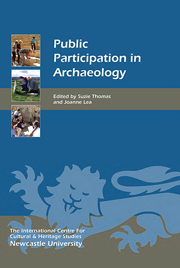Book contents
- Frontmatter
- Dedication
- Contents
- List of Illustrations
- Acknowledgments
- List of Abbreviations
- Preface
- Introduction
- Public Participation in Archaeology: International Models
- Public Participation in Archaeology Through Education
- Public Participation in Archaeology Through Tourism
- 10 Politics, Archaeology and Education: Ancient Merv, Turkmenistan
- 11 Situating Public Archaeology in Crooked Tree, Belize
- 12 Access to Archaeological Heritage in Mexico: Its Impact on Public Participation in Archaeology
- Public Participation in Archaeology Through Site Management and conservation
- List of Contributors
- Index
10 - Politics, Archaeology and Education: Ancient Merv, Turkmenistan
from Public Participation in Archaeology Through Tourism
Published online by Cambridge University Press: 05 August 2014
- Frontmatter
- Dedication
- Contents
- List of Illustrations
- Acknowledgments
- List of Abbreviations
- Preface
- Introduction
- Public Participation in Archaeology: International Models
- Public Participation in Archaeology Through Education
- Public Participation in Archaeology Through Tourism
- 10 Politics, Archaeology and Education: Ancient Merv, Turkmenistan
- 11 Situating Public Archaeology in Crooked Tree, Belize
- 12 Access to Archaeological Heritage in Mexico: Its Impact on Public Participation in Archaeology
- Public Participation in Archaeology Through Site Management and conservation
- List of Contributors
- Index
Summary
Background
Turkmenistan is a large country (as large as Spain; more than twice the size of the United Kingdom), sparsely populated (4—5 million people, according to unofficial estimates) and predominantly covered by one of the world's largest deserts. In summer the temperature is rarely below 35°C and can reach 50°C in the desert; in the winter it can drop to -20°C. Turkmenistan also has different landscapes, ranging from mountains to fertile oases.
History
Immediately before 1991, Turkmenistan was one of a number of the Soviet provinces which then became republics. The borders of modern Turkmenistan were drawn in the 1920s as part of the Soviet delimitation of Central Asia and, following Soviet modernisation and indigenisation policies, saw systematisation of the Turkmen language and culture (Haugen 2003; Edgar 2004). When Turkmenistan was given its independence in 1991 following the unexpected collapse of the USSR, it had all the attributes of a Soviet republic including institutions of education, culture and healthcare. Turkmenistan's development as an independent country since 1991 is heavily linked to the ideological visions of the late dictator, Saparmurat Niyazov, and his successor, Gurbanguly Berdimuhamedov.
- Type
- Chapter
- Information
- Public Participation in Archaeology , pp. 119 - 128Publisher: Boydell & BrewerPrint publication year: 2014

